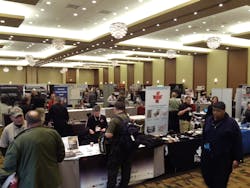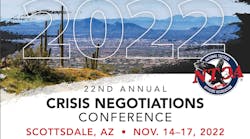Note: More information on the show can be found at ILEETA.org. There they feature links and resources for online training.
This past spring I took the opportunity to attend a day at the ILEETA (International Law Enforcement Educators and Trainers Association) Conference and Expo in Wheeling, Illinois. The schedule itself took on five days packed with various sessions, challenges, and demos on a live-fire range—not to mention the rows of vendor booths. Here at LET we trade shows like these between the editorial staff, and it’s been awhile since I’ve attended. The show has grown. Vendors included universities, publishers, training providers, training equipment, firearms, clothing, duty gear, fitness equipment, simulators, and more.
As expected the main hallway had a lineup of law enforcement training authors during the scheduled meet-and-greet. Richard Fairburn, Ed Santos, Ron Scheidt, Jonathan Page, William Pelarenos, Vicki and John Farnam, and Dr. Joel Shults were all on-hand for attendees to talk, network, purchase a book or simply get one signed.
Next door to the expo held the ILEETA Cup: a competitive event sponsored by MILO Range and FAAC Inc. using each company’s simulators. Participation was dedicated to the ILEETA Scholarship Fund—funding the attendance of members unable to afford registration. Large screens lit up a dark room. There MILO Range placed officers on a computer-generated range letting the software create their score. FAAC strapped participants in a chair and, like the computerized range, engulfed their vision with a situation. I sat in the FAAC’s Driving Force simulator at a different event—humbly I admit that without the proper training I crashed once the situation got “hairy.” There’s no faking it. You either have the training or you don’t. These simulators put that to the test. Thankfully the truck I ran into back then was digital.
Other notable events throughout the week included:
- “The Emerson Hour”, sponsored by Calibre Press
- An outdoor BBQ dinner, sponsored by 5.11 Tactical
- Lunch and fun trivia contest with prizes, sponsored by Armor Express
- Member appreciation, sponsored by SABRE - Security Equipment Corp.
- As well as a special presentation of first-hand experiences from patrol and SWAT operations in “Surviving Armed Encounters: Real Stories from Real Cops”, sponsored by Winning Mind Training
The sessions
Miami Gardens. Ferguson. New York. Madison. Baltimore. Talking-head news channels pop on every once and awhile at my house. If these were my only source of news, I’d say law enforcement has a public relations problem. While there wasn’t a published “theme” to the entire week, there seemed to be a special angle towards battling a negative perception from the public and talking about various issues on the aftermath of potentially controversial situations.
With more than 140 courses, many of which provided certification, sessions included armorer courses, firearms training, instructor development, live fire, management/leadership, officer survival/tactics, specialized training, wellness, and use-of-force. Presenters ranged from various agencies from around the U.S., ILEETA advisory board members, as well as instructors from a few vendors.
The first session was “Survive & Succeed: Saving Your Officers and Your Department,” from Sgt. Steven Ashley (Ret.), Livingston County Sheriff’s Department. The show’s program describes it as, We talk a lot about officer safety, but we tend to emphasize the “big things”, when often it’s attention to detail that’s important. … This course will focus on “sweating the small stuff”, while emphasizing ‘Smart Use’ and ‘Best Practice’ doctrines in keeping officers safer, both on the street and in the jail. Remember, what gets you hurt is what gets you sued, so Work Safer, Get Sued Less!
Early in the talk, Sgt. Ashley asked an unusual question: Who’s been sued? He brought up public perception and the myth of the “routine” day. I believe the theory behind the period was that the training of officers to safety, not liability, would lower the number of legal actions against them. “The thing you’ve done the best,” he says, “is trained cops to be afraid of being in trouble.” And therein lay the department’s guidelines. One of the many suggestions was to make sure your policies, regulations, rules, and procedures are adaptable, explaining that they can break down in certain situations and why. Reminding everyone to be careful with words and never use “must,” “always,” never,” or “will.” I couldn’t agree more; always remember that you must never use these words. He spoke on high risk gear, after-action review, and noted that he would like to see documentation added to use-of-force training. Which, if you think about it, makes sense.
Later in the day I attended “Improving Police Interactions with Transgender Individuals”, by President Jan Redfern of Redfern Strategic Medical Communications. Its description: Law enforcement personnel may encounter a continuum of gender diversity not reflected in traditional gender stereotypes of male and female. Individuals crossing culturally defined categories of gender are referred to as transgender. This course will help police departments develop sensitivity training programs 1) to increase awareness of transgender culture and its diversity and 2) to review practical suggestions and guidelines to improve interactions with transgender individuals and avoid litigation and civil rights violations.
Everyone is different. And since no day is “routine”, every day will be different as well. So I was curious as to what such a session had to say about interacting with the transgender (TG) community. This minority is estimated to be 0.25 to 1 percent of the U.S. population. Of that, in a NCTG Equality survey from 2011, it is reported that 54 percent have had contact with police and 46 percent are uncomfortable with law enforcement. Redfern held an open talk, welcoming questions as they came up, but wanted to be clear she wasn’t providing guidelines but showcasing the unique challenges and discussing some best practices instead. She recommended developing guidelines for the department, and discussing new ways to think about such a unique situation using the TG Working Group of the LAPD as an example. Other great examples included NYC, Boston, Washington D.C., Chicago, and Philadelphia.
One dealt with potential causes of incidents, while another discussed how awareness can help ten-fold. “Treat people with respect,” says Redfern. I’d say Sgt. Ashley would agree, “What gets you sued also gets you hurt ... so stay smart, stay safe.” Will one show, one training session solve every issue? No, but they are another piece of a massive puzzle. If you’re to start somewhere, why not there?



